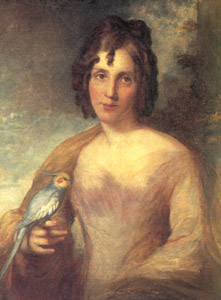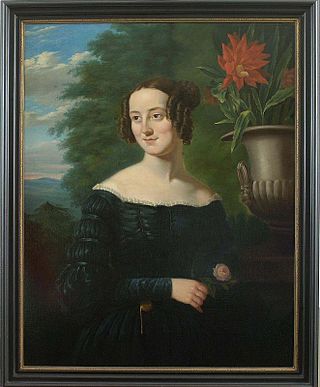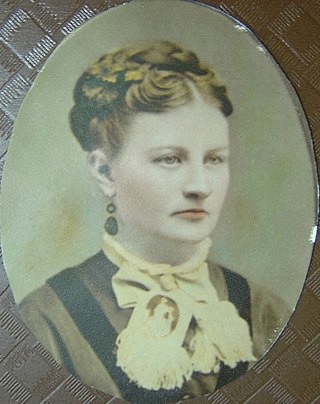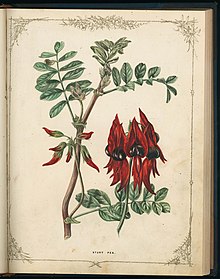
John Gould was an English ornithologist who published monographs on birds, illustrated by plates produced by his wife, Elizabeth Gould, and several other artists, including Edward Lear, Henry Constantine Richter, Joseph Wolf and William Matthew Hart. He has been considered the father of bird study in Australia and the Gould League in Australia is named after him. His identification of the birds now nicknamed "Darwin's finches" played a role in the inception of Darwin's theory of evolution by natural selection. Gould's work is referenced in Charles Darwin's book, On the Origin of Species.

Elizabeth Gould,, was a British artist and illustrator at the forefront of the natural history movement. Elizabeth traveled and worked alongside her husband, naturalist and author John Gould. She produced illustrations and lithographs for ornithological works, including plates in Darwin's The Zoology of the Voyage of H.M.S. Beagle and the Goulds' seminal work The Birds of Australia. In total, Elizabeth is accredited to at least 650 works.

Franz Andreas Bauer was an Austrian microscopist and botanical artist. The standard author abbreviation F.A.Bauer is used to indicate this person as the author when citing a botanical name.

Henry Cranke Andrews, was an English botanist, botanical artist and engraver. As he always published as Henry C. Andrews, and due to difficulty finding records, the C. was often referred to as Charles, until a record of his marriage registration was found in 2017.

Botanical illustration is the art of depicting the form, color, and details of plant species. They are generally meant to be scientifically descriptive about subjects depicted and are often found printed alongside a botanical description in books, magazines, and other media. Some are sold as artworks. Often composed by a botanical illustrator in consultation with a scientific author, their creation requires an understanding of plant morphology and access to specimens and references.

Ebenezer Edward Gostelow was an Australian painter of flowers, birds and butterflies.

James Andrews (1801–1876) was an English draughtsman, botanical painter and illustrator noted for his accomplished illustrations. He also taught flower-painting to young ladies. He created the illustrations for the famous nature writer Sarah Bowdich Lee's 1854 book Trees, Plants, and Flowers: Their Beauties, Uses, and Influences.

Margaret Lilian Flockton, is most commonly recognized as a botanical artist famous for her botanical illustrations of "The Forest Flora of New South Wales", "A Critical Revision of the Genus Eucalyptus", and the genus Opuntia, all by the botanist and forester, Joseph Henry Maiden. She was also a painter, commercial artist, and art teacher at different points of her life. She was the first botanical illustrator at the Royal Botanic Gardens in Sydney. She was also the first female lithographer in Australia which gave her a high reputation at the time.

Berthe Hoola van Nooten, was a Dutch botanical artist, noted for her botanical plates illustrating "Fleurs, Fruits et Feuillages Choisis de l'Ile de Java" in 1863-64. Hoola van Nooten is denoted by the author abbreviation Hoola van Nooten when citing a botanical name.
Harriet Gouldsmith was an English landscape painter and etcher.
Marjorie Netta Blamey MBE was an English painter and illustrator, particularly noted for her botanical illustrations for which she was described as "the finest living botanical illustrator", "the best contemporary botanical illustrator" and "the top illustrator in Europe" in reviews around the world.

Arabella Elizabeth Roupell was an English flower painter, noted for an anonymous set of flower paintings published in 1849 under the title 'Specimens of the flora of South Africa by a Lady.'

Margaret Neilson Armstrong (1867–1944) was a 19th and early 20th-century American book cover designer, illustrator, and author. She is best known for her book covers influenced by Art Nouveau. She also wrote and illustrated the first comprehensive guide to wildflowers of the American west, Field Book of Western Wild Flowers (1915). In later life, she wrote two popular biographies and three mystery novels.
Catherine Teresa Cookson or Mrs James Cookson was an Irish botanical artist, who documented some of the botany of India.

Emma Homan Thayer (1842–1908) was a 19th-century American botanical artist and author of books about native wildflowers. She also wrote several novels.

Mary Elizabeth Parsons was the writer of an early comprehensive guide to California wildflowers.

Agnes Dunbar Fitzgibbon Chamberlin was a Canadian artist living in Ontario.

Maria Morris Miller (1813–1875) was a Canadian artist from Halifax, Nova Scotia who is known for her botanical paintings and illustrations. She presented her work to Queen Victoria and received royal patronage for life. She is also the first professional woman artist in Nova Scotia, recognized in her field during her active career years. She worked with scientists and government officials, garnering her accolades as the "Audubon of Nova Scotian field flowers".
Elizabeth Vivienne Conabere was an Australian botanical artist, writer and conservationist. Conabere provided paintings and illustrations of plants for publications and series of stamps, and exhibited her works in galleries across her home state of Victoria, Australia. Among her works are Wildflowers of South-eastern Australia (1974) and An Australian Countrywoman's Diary (1986). Conabere was also active in conservation institutions.
Fanny Anne Charsley was a botanical artist and collector. She collected plants for the Victorian government botanist, Baron Ferdinand von Mueller who named the Australian flower Helipterum charsleyae in her honour. The flower has since been reclassified as Rhodanthe charsleyae and is a species of paper daisy. Her publication Wild Flowers Around Melbourne was one of the first books on Victorian flora aimed at the general public.















